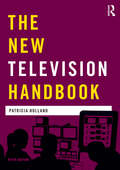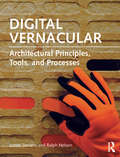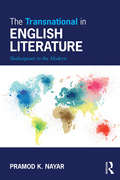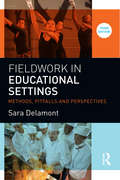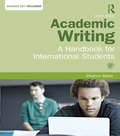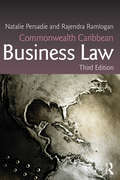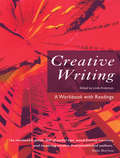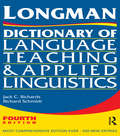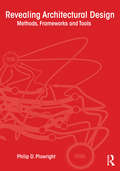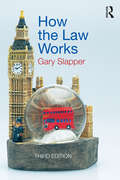- Table View
- List View
The New Television Handbook (Media Practice)
by Patricia HollandThe New Television Handbook?provides an exploration of the theory and practice of television at a time when the medium is undergoing radical changes. The book looks at television from the perspective of someone new to the industry, and explores the place of the medium within a?constantly changing digital landscape. This title discusses key skills involved in television production, including: producing, production management, directing, camera, sound, editing and visual effects. Each of these activities is placed within a wider context as it traces the production process from commissioning to post-production. The book outlines the broad political and economic context of the television industry. It gives an account of television genres, in particular narrative, factual programmes and news, and it considers the academic discipline of media studies and the ways in which theorists have analysed and tried to understand the medium. It points to the interplay of theory and practice as it draws on the history of the medium and observes the ways in which the past continues to influence and invigorate the present. The New Television Handbook?includes: contributions from practitioners ranging from established producers to new entrants; a comprehensive list of key texts and television programmes; a revised glossary of specialist terms; a section on training and ways of getting into the industry. By combining theory, real-world advice and a detailed overview of the industry and its history,?The New Television Handbook?is an ideal guide for students of media and television studies and young professionals entering the television industry.
Digital Vernacular: Architectural Principles, Tools, and Processes
by James Stevens Ralph NelsonDigital Vernacular addresses the why and how of digital fabrication in hundreds of step-by-step color images, illuminating a set of working principles and techniques that join theory with practice. Authors James Stevens and Ralph Nelson reconcile local traditions and innovations with globally accessible methods and digital toolsets. By combining ethics with hardware, the book will root you in the origins of making, ensuring a lasting and relevant reference for your studio practice. The book opens with the origins and principles of the digital vernacular, then outlines digital vernacular tools including computer numerically controlled (CNC) mills, laser cutters, and 3D printers. You'll even learn to create your own digital fabrication tools out of inexpensive materials. The book concludes with the processes of the digital vernacular, including techniques for removing, joining, forming, and adding. A companion website at make-Lab.org hosts additional step-by-step processes and project outcomes.
Digital Vernacular: Architectural Principles, Tools, and Processes
by James Stevens Ralph NelsonDigital Vernacular addresses the why and how of digital fabrication in hundreds of step-by-step color images, illuminating a set of working principles and techniques that join theory with practice. Authors James Stevens and Ralph Nelson reconcile local traditions and innovations with globally accessible methods and digital toolsets. By combining ethics with hardware, the book will root you in the origins of making, ensuring a lasting and relevant reference for your studio practice. The book opens with the origins and principles of the digital vernacular, then outlines digital vernacular tools including computer numerically controlled (CNC) mills, laser cutters, and 3D printers. You'll even learn to create your own digital fabrication tools out of inexpensive materials. The book concludes with the processes of the digital vernacular, including techniques for removing, joining, forming, and adding. A companion website at make-Lab.org hosts additional step-by-step processes and project outcomes.
The Insider’s Guide to Legal Skills
by Emily Allbon Sanmeet Kaur DuaConfused by cases? Stuck on statutes? Or just unsure where to start with writing, research or revision? The Insider’s Guide to Legal Skills will show you what you need to succeed, applying skills in their real-world context and helping you get to grips with legal method and thinking. Making use of problem-based learning and examples throughout, this practical and accessible guide will provide you with a clear guide to skills within the law degree and how to make the most of them in assessment, but also help you to see their importance to a future legal career. Designed for LLB/GDL students who want a clear overview of what a law degree is all about, the book has been built on the skills curriculum, and is a suitable text for Legal Skills, Methods and Reasoning courses as well as a general introduction to law, or pre-reading for those considering a law degree.
The Transnational in English Literature: Shakespeare to the Modern
by Pramod K. NayarThe Transnational in English Literature examines English literary history through its transnational engagements and argues that every period of English Literature can be examined through its global relations. English identity and nationhood is therefore defined through its negotiation with other regions and cultures. The first book to look at the entirety of English literature through a transnational lens, Pramod Nayar: Maps the discourses that constitute the global in every age, from the Early Modern to the twentieth century Offers readings of representative texts in poetry, fiction, essay and drama, covering a variety of genres such as Early Modern tragedy, the adventure novel, the narrative poem, Gothic and utopian fiction Examines major authors including Shakespeare, Defoe, Behn, Swift, Coleridge, Wordsworth, Austen, Mary Shelley, the Brontës, Doyle, Ballantyne, Orwell, Conrad, Kipling, Forster Looks at themes such as travel and discovery, exoticism, mercantilism, commodities, the civilisational mission and the multiculturalization of England. Useful for students and academics alike this book offers a comprehensive survey of the English canon questioning and analysing the transnational and global engagements of English literature.
Fieldwork in Educational Settings: Methods, pitfalls and perspectives
by Sara DelamontFieldwork in Educational Settings is widely recognised as part of the essential reading for the researcher in education. It instructs those new to qualitative educational research how to find interesting research sites, collect great data, analyse them responsibly, and then find the right audience to hear, use, and build upon their findings successfully. The revised and updated third edition includes the latest developments in authoethnography, data collection, analysis and dissemination, and is illustrated throughout with up-to-the minute examples of real world research. It embraces both sociological and anthropological approaches to qualitative educational research, using case studies from the USA, Canada, Australia and New Zealand as well as the UK. ‘Education’ is treated broadly, including higher education and non-formal settings as well as schools. Threaded throughout the book is updated content on: the internet and virtual worlds as sites for ethnography, the ethical aspects of ethnographic research, the strengths and weaknesses of autoethnography, the debates about representing data, the impact of technological innovations in all stages of qualitative research. An indispensable introduction for students and novice researchers alike, the new edition continues to illustrate and sustain the increasing popularity of qualitative methods in educational research over the past thirty years, addressing the technological and digital changes that have occurred.
Academic Writing: A Handbook for International Students
by Stephen BaileyMost international students need to write essays and reports for exams and coursework, but writing good academic English is one of the most demanding tasks students face. This new, fourth edition of Academic Writing: A Handbook for International Students has been completely revised to help students reach this goal. The four main parts of Academic Writing are: The writing process Elements of writing Vocabulary for writing Writing models Each part is divided into short units which contain examples, explanations and exercises, for use in the classroom or for self-study. The units are clearly organised to allow teachers and students find the help they need with writing tasks, while cross-referencing allows easy access to relevant sections. In the first part, each stage of the writing process is demonstrated and practised, from selecting suitable sources, reading, note-making and planning through to re-writing and proof-reading. The fourth edition of this popular course builds on the success of the earlier editions, and has a special focus on the vital topic of academic vocabulary in part three, Vocabulary for Writing. Part three deals with areas such as nouns and adjectives, adverbs and verbs, synonyms, prefixes and prepositions, in an academic context. More key features of the book include: All elements of writing are clearly explained, with a full glossary for reference Models provided for all types of academic texts: essays, reports, reviews and case-studies Full range of practice exercises, with answer key included Use of authentic academic texts A companion website offers further practice with a range of additional exercises Fully updated, with sections on finding electronic sources and evaluating internet material All international students wanting to maximise their academic potential will find this practical and easy-to-use book an invaluable guide to writing in English for their degree courses.
Academic Writing: A Handbook for International Students
by Stephen BaileyMost international students need to write essays and reports for exams and coursework, but writing good academic English is one of the most demanding tasks students face. This new, fourth edition of Academic Writing: A Handbook for International Students has been completely revised to help students reach this goal. The four main parts of Academic Writing are: The writing process Elements of writing Vocabulary for writing Writing models Each part is divided into short units which contain examples, explanations and exercises, for use in the classroom or for self-study. The units are clearly organised to allow teachers and students find the help they need with writing tasks, while cross-referencing allows easy access to relevant sections. In the first part, each stage of the writing process is demonstrated and practised, from selecting suitable sources, reading, note-making and planning through to re-writing and proof-reading. The fourth edition of this popular course builds on the success of the earlier editions, and has a special focus on the vital topic of academic vocabulary in part three, Vocabulary for Writing. Part three deals with areas such as nouns and adjectives, adverbs and verbs, synonyms, prefixes and prepositions, in an academic context. More key features of the book include: All elements of writing are clearly explained, with a full glossary for reference Models provided for all types of academic texts: essays, reports, reviews and case-studies Full range of practice exercises, with answer key included Use of authentic academic texts A companion website offers further practice with a range of additional exercises Fully updated, with sections on finding electronic sources and evaluating internet material All international students wanting to maximise their academic potential will find this practical and easy-to-use book an invaluable guide to writing in English for their degree courses.
Commonwealth Caribbean Business Law (Commonwealth Caribbean Law)
by Natalie Persadie Rajendra RamloganNow in its third edition, Commonwealth Caribbean Business Law continues to break away from the traditional English approach of treating business law primarily as the law of contract and agency. Taking a panoramic view, it explores the foundation of various legal systems before examining areas of legal liability that affect business activities. These include areas such as contract law, tort law, criminal law, agency and internet law which present significant challenges confronting the business sector. The book primarily targets the development of business law principles in several Caribbean Commonwealth jurisdictions but, where appropriate, also embraces the jurisprudence of other Commonwealth nations, such as the United Kingdom, Canada and Australia. It also explores the United States as a non-Commonwealth jurisdiction, given the increasing importance in the Caribbean of judicial pronouncements relating to internet law from this territory. Using excerpts from key judgments, the book allows students, particularly those with a non-legal background, to understand key legal principles for business as presented by the judiciary and draws parallels between legal theory and business practice.
Researching for the Media: Television, Radio and Journalism
by Adele EmmResearching for the Media: Television, Radio and Journalism is an essential guide to researching for the media industry. It explains the role of the researcher and journalist within radio, television and journalism exploring key areas of what to expect in the job. Researching for the Media: Television, Radio and Journalism offers advice and instruction on practical, ethical and legal issues which affect anyone working in these industries. Beginning with suggestions on how to think up ideas and how to devise treatments, through to general research methods and techniques and guidance on working on location at home and abroad, it uses real examples of good and bad practice from the industry. Written by an experienced researcher, writer and producer, Researching for the Media includes: Tips on finding contributors from contestants, experts and specialists through to audiences and celebrities How to find photographs, picture and film clips and the ethical and legal issues involved Advice on finding and using music and copyright issues How the media uses the internet and social media such as Twitter, Facebook, Instagram A discussion of risk assessment, codes of conduct, ethical behaviour and legal and safety issues A glossary of media terms, further reading and a list of helpful websites. Discover more at www.adeleemm.com
Researching for the Media: Television, Radio and Journalism
by Adele EmmResearching for the Media: Television, Radio and Journalism is an essential guide to researching for the media industry. It explains the role of the researcher and journalist within radio, television and journalism exploring key areas of what to expect in the job. Researching for the Media: Television, Radio and Journalism offers advice and instruction on practical, ethical and legal issues which affect anyone working in these industries. Beginning with suggestions on how to think up ideas and how to devise treatments, through to general research methods and techniques and guidance on working on location at home and abroad, it uses real examples of good and bad practice from the industry. Written by an experienced researcher, writer and producer, Researching for the Media includes: Tips on finding contributors from contestants, experts and specialists through to audiences and celebrities How to find photographs, picture and film clips and the ethical and legal issues involved Advice on finding and using music and copyright issues How the media uses the internet and social media such as Twitter, Facebook, Instagram A discussion of risk assessment, codes of conduct, ethical behaviour and legal and safety issues A glossary of media terms, further reading and a list of helpful websites. Discover more at www.adeleemm.com
SPSS Explained
by Perry R. Hinton Isabella McMurray Charlotte BrownlowSPSS Explained provides the student with all that they need to undertake statistical analysis using SPSS. It combines a step-by-step approach to each procedure with easy to follow screenshots at each stage of the process. A number of other helpful features are provided: regular advice boxes with tips specific to each test explanations divided into ‘essential’ and ‘advanced’ sections to suit readers at different levels frequently asked questions at the end of each chapter. The first edition of this popular book has been fully updated for IBM SPSS version 21 and also includes: chapters that explain bootstrapping and how this is used an introduction to binary logistic regression coverage of new features such as Chart Builder. Presented in full colour and with a fresh, reader-friendly layout, this fully updated new edition also comes with a companion website featuring an array of supplementary resources for students. The authors have many years of experience in teaching SPSS to students from a wide range of disciplines. Their understanding of SPSS users’ concerns, as well as a knowledge of the type of questions students ask, form the foundation of this book. Minimal prior knowledge is assumed, so the book is well designed for the novice user, but it will also be a useful reference source for those developing their own expertise in SPSS. It is suitable for all students who need to do statistical analysis using SPSS in various departments including Psychology, Social Science, Business Studies, Nursing, Education, Health and Sport Science, Communication and Media, Geography, and Biology.
SPSS Explained
by Perry R. Hinton Isabella McMurray Charlotte BrownlowSPSS Explained provides the student with all that they need to undertake statistical analysis using SPSS. It combines a step-by-step approach to each procedure with easy to follow screenshots at each stage of the process. A number of other helpful features are provided: regular advice boxes with tips specific to each test explanations divided into ‘essential’ and ‘advanced’ sections to suit readers at different levels frequently asked questions at the end of each chapter. The first edition of this popular book has been fully updated for IBM SPSS version 21 and also includes: chapters that explain bootstrapping and how this is used an introduction to binary logistic regression coverage of new features such as Chart Builder. Presented in full colour and with a fresh, reader-friendly layout, this fully updated new edition also comes with a companion website featuring an array of supplementary resources for students. The authors have many years of experience in teaching SPSS to students from a wide range of disciplines. Their understanding of SPSS users’ concerns, as well as a knowledge of the type of questions students ask, form the foundation of this book. Minimal prior knowledge is assumed, so the book is well designed for the novice user, but it will also be a useful reference source for those developing their own expertise in SPSS. It is suitable for all students who need to do statistical analysis using SPSS in various departments including Psychology, Social Science, Business Studies, Nursing, Education, Health and Sport Science, Communication and Media, Geography, and Biology.
Creative Writing: A Workbook with Readings
by Linda AndersonCreative Writing is a complete writing course that will jump-start your writing and guide you through your first steps towards publication. Suitable for use by students, tutors, writers’ groups or writers working alone, this book offers: a practical and inspiring section on the creative process, showing you how to stimulate your creativity and use your memory and experience in inventive ways in-depth coverage of the most popular forms of writing, in extended sections on fiction, poetry and life writing, including biography and autobiography, giving you practice in all three forms so that you might discover and develop your particular strengths a sensible, up-to-date guide to going public, to help you to edit your work to a professional standard and to identify and approach suitable publishers a distinctive collection of exciting exercises, spread throughout the workbook to spark your imagination and increase your technical flexibility and control a substantial array of illuminating readings, bringing together extracts from contemporary and classic writings in order to demonstrate a range of techniques that you can use or adapt in your own work. Creative Writing: A Workbook with Readings presents a unique opportunity to benefit from the advice and experience of a team of published authors who have also taught successful writing courses at a wide range of institutions, helping large numbers of new writers to develop their talents as well as their abilities to evaluate and polish their work to professional standards. These institutions include Lancaster University and the University of East Anglia, renowned as consistent producers of published writers.
Creative Writing: A Workbook with Readings
by Linda AndersonCreative Writing is a complete writing course that will jump-start your writing and guide you through your first steps towards publication. Suitable for use by students, tutors, writers’ groups or writers working alone, this book offers: a practical and inspiring section on the creative process, showing you how to stimulate your creativity and use your memory and experience in inventive ways in-depth coverage of the most popular forms of writing, in extended sections on fiction, poetry and life writing, including biography and autobiography, giving you practice in all three forms so that you might discover and develop your particular strengths a sensible, up-to-date guide to going public, to help you to edit your work to a professional standard and to identify and approach suitable publishers a distinctive collection of exciting exercises, spread throughout the workbook to spark your imagination and increase your technical flexibility and control a substantial array of illuminating readings, bringing together extracts from contemporary and classic writings in order to demonstrate a range of techniques that you can use or adapt in your own work. Creative Writing: A Workbook with Readings presents a unique opportunity to benefit from the advice and experience of a team of published authors who have also taught successful writing courses at a wide range of institutions, helping large numbers of new writers to develop their talents as well as their abilities to evaluate and polish their work to professional standards. These institutions include Lancaster University and the University of East Anglia, renowned as consistent producers of published writers.
Design-Tech: Building Science for Architects
by Jason Alread Thomas Leslie Robert WhiteheadDesign-Tech is an indispensable, holistic approach to architectural technology that shows you in hundreds of drawings and tables the why as well as the how of building science, providing you with a comprehensive overview. In this expanded edition, measurements and examples are listed in both metric and imperial units to reflect the global reality of architectural practice. The authors also address digital fabrication, construction documentation, ultra-high-rise structures, and zoning codes. And there's more in-depth coverage of structural design and greater emphasis on environmental forces. Numerous case studies demonstrate real-world design implications for each topic, so that you can integrate technical material with design sensibilities. Short chapters explain each topic from first principles in easy-to-reference formats, focusing on what you need to know both at the drawing board and in future discussions with engineers, contractors, and consultants. This new edition incorporates material from continuing curricular experimentation in the SCI-TECH sequence at Iowa State University, which has been recognized with awards and funding from the American Institute of Architects, the U.S. Green Building Council, and the National Council of Architectural Registration Boards.
Design-Tech: Building Science for Architects
by Jason Alread Thomas Leslie Robert WhiteheadDesign-Tech is an indispensable, holistic approach to architectural technology that shows you in hundreds of drawings and tables the why as well as the how of building science, providing you with a comprehensive overview. In this expanded edition, measurements and examples are listed in both metric and imperial units to reflect the global reality of architectural practice. The authors also address digital fabrication, construction documentation, ultra-high-rise structures, and zoning codes. And there's more in-depth coverage of structural design and greater emphasis on environmental forces. Numerous case studies demonstrate real-world design implications for each topic, so that you can integrate technical material with design sensibilities. Short chapters explain each topic from first principles in easy-to-reference formats, focusing on what you need to know both at the drawing board and in future discussions with engineers, contractors, and consultants. This new edition incorporates material from continuing curricular experimentation in the SCI-TECH sequence at Iowa State University, which has been recognized with awards and funding from the American Institute of Architects, the U.S. Green Building Council, and the National Council of Architectural Registration Boards.
The Essential Guide for Competent Teaching Assistants: Meeting the National Occupational Standards at Level 2
by Anne WatkinsonThis indispensable textbook provides the underpinning knowledge to support all teaching assistants working towards Level 2 of the National Occupational Standards. This new edition is fully revised and extended to incorporate and respond to all new materials required to meet the 2007 standards. Taking into account current initiatives including Workforce Remodelling and the Every Child Matters agenda, the book can be used to support NVQs, or other Teaching Assistant awards at level 2, or can be used simply to supplement good practice. This accessible companion: actively engages the reader in activities, developing reflective practice while giving the theoretical background to school-based work gives insight and information about pupils’ individual needs helps teaching assistants develop curriculum-based skills to enable more effective classroom support emphasises that teaching assistants are team members, supporting the school and being supported by the school. Contributions from specialist advisers ensure that the ideas and techniques are up to date, relevant and the best practice. All phases of education are covered, from the early years to later secondary years, and references are made to sources of further information throughout the book. The Essential Guide for Competent Teaching Assistants is invaluable in supporting both study and everyday practice. It will also be useful to training providers, teachers and school managers supporting Teaching Assistants in their professional development.
The Essential Guide for Competent Teaching Assistants: Meeting the National Occupational Standards at Level 2
by Anne WatkinsonThis indispensable textbook provides the underpinning knowledge to support all teaching assistants working towards Level 2 of the National Occupational Standards. This new edition is fully revised and extended to incorporate and respond to all new materials required to meet the 2007 standards. Taking into account current initiatives including Workforce Remodelling and the Every Child Matters agenda, the book can be used to support NVQs, or other Teaching Assistant awards at level 2, or can be used simply to supplement good practice. This accessible companion: actively engages the reader in activities, developing reflective practice while giving the theoretical background to school-based work gives insight and information about pupils’ individual needs helps teaching assistants develop curriculum-based skills to enable more effective classroom support emphasises that teaching assistants are team members, supporting the school and being supported by the school. Contributions from specialist advisers ensure that the ideas and techniques are up to date, relevant and the best practice. All phases of education are covered, from the early years to later secondary years, and references are made to sources of further information throughout the book. The Essential Guide for Competent Teaching Assistants is invaluable in supporting both study and everyday practice. It will also be useful to training providers, teachers and school managers supporting Teaching Assistants in their professional development.
Longman Dictionary of Language Teaching and Applied Linguistics
by Jack C. Richards Richard W. SchmidtThis best-selling dictionary is now in its 4th edition. Specifically written for students of language teaching and applied linguistics, it has become an indispensible resource for those engaged in courses in TEFL, TESOL, applied linguistics and introductory courses in general linguistics. Fully revised, this new edition includes over 350 new entries. Previous definitions have been revised or replaced in order to make this the most up-to-date and comprehensive dictionary available. Providing straightforward and accessible explanations of difficult terms and ideas in applied linguistics, this dictionary offers: Nearly 3000 detailed entries, from subject areas such as teaching methodology, curriculum development, sociolinguistics, syntax and phonetics. Clear and accurate definitions which assume no prior knowledge of the subject matter helpful diagrams and tables cross references throughout, linking related subject areas for ease of reference, and helping to broaden students' knowledgeThe Dictionary of Language Teaching and Applied Linguistics is the definitive resource for students.
Longman Dictionary of Language Teaching and Applied Linguistics
by Jack C. Richards Richard W. SchmidtThis best-selling dictionary is now in its 4th edition. Specifically written for students of language teaching and applied linguistics, it has become an indispensible resource for those engaged in courses in TEFL, TESOL, applied linguistics and introductory courses in general linguistics. Fully revised, this new edition includes over 350 new entries. Previous definitions have been revised or replaced in order to make this the most up-to-date and comprehensive dictionary available. Providing straightforward and accessible explanations of difficult terms and ideas in applied linguistics, this dictionary offers: Nearly 3000 detailed entries, from subject areas such as teaching methodology, curriculum development, sociolinguistics, syntax and phonetics. Clear and accurate definitions which assume no prior knowledge of the subject matter helpful diagrams and tables cross references throughout, linking related subject areas for ease of reference, and helping to broaden students' knowledgeThe Dictionary of Language Teaching and Applied Linguistics is the definitive resource for students.
How to Write Essays and Dissertations: A Guide for English Literature Students
by Alan Durant Nigel FabbThe first book that literature students should read, this guide reveals the distinct set of skills, conventions and methods of essay and dissertation writing.Taking students through the various stages of writing, from planning to final submission, it offers specific guidelines and a lively, detailed commentary on actual examples of student work at each stage.
Revealing Architectural Design: Methods, Frameworks and Tools
by Philip PlowrightRevealing Architectural Design examines the architectural design process from the point of view of knowledge domains, domain syntax, coherence, framing, thinking styles, decision-making and testing. Using straightforward language, the book connects general design thinking to underlying frameworks that are used in the architectural design process. The book provides historical grounding as well as clear examples of real design outcomes. It includes diagrams and explanations to make that content accessible. The frameworks and their methods are described by what they can accomplish, what biases they introduce and the use of their final outcomes. Revealing Architectural Design is an advanced primer useful to anyone interested in increasing the quality of their architectural design proposals through understanding the conceptual tools used to achieve that process. While it is intended for undergraduate and graduate students of architectural design, it will also be useful for experienced architectural practitioners. For the non-architect, this book opens a window into the priorities of a discipline seldom presented with such transparency.
Revealing Architectural Design: Methods, Frameworks and Tools
by Philip PlowrightRevealing Architectural Design examines the architectural design process from the point of view of knowledge domains, domain syntax, coherence, framing, thinking styles, decision-making and testing. Using straightforward language, the book connects general design thinking to underlying frameworks that are used in the architectural design process. The book provides historical grounding as well as clear examples of real design outcomes. It includes diagrams and explanations to make that content accessible. The frameworks and their methods are described by what they can accomplish, what biases they introduce and the use of their final outcomes. Revealing Architectural Design is an advanced primer useful to anyone interested in increasing the quality of their architectural design proposals through understanding the conceptual tools used to achieve that process. While it is intended for undergraduate and graduate students of architectural design, it will also be useful for experienced architectural practitioners. For the non-architect, this book opens a window into the priorities of a discipline seldom presented with such transparency.
How the Law Works
by Gary SlapperHow the Law Works is a refreshingly clear and reliable guide to the legal system in the UK. Offering interesting and comprehensive coverage, it makes sense of all the curious features of the law in day to day life and in current affairs. Explaining the law and legal jargon in plain English, it provides an accessible entry point to the different types of law and legal techniques, as well as the impact of European law and human rights law. In addition to explaining the role of judges, lawyers, juries and parliament, it clarifies the mechanisms behind criminal and civil law. How the Law Works is essential reading for anyone approaching law for the first time, or for anyone who is interested in an engaging introduction to the subject’s bigger picture.
